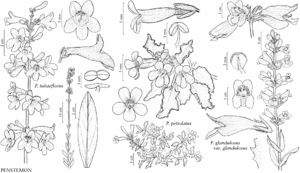Penstemon tubaeflorus
Trans. Amer. Philos. Soc., n. s. 5: 181. 1835. (as Pentstemon tubaeflorum)
Herbs. Stems erect, 25–85(–100) cm, glabrous, not glaucous. Leaves basal and cauline, basal often withering by anthesis, not leathery, glabrous; basal and proximal cauline 25–110 × 6–38 mm, blade spatulate to ovate, base tapered, margins entire or ± serrate, apex rounded to obtuse; cauline 5–8(–10) pairs, sessile, 15–100(–135) × 4–20(–38) mm, blade ovate to lanceolate, base tapered to clasping, margins entire or ± serrate, apex acute to acuminate. Thyrses interrupted, cylindric, 8–30(–40) cm, axis glandular-pubescent, verticillasters 4–8(–12), cymes 3–9-flowered, 2 per node; proximal bracts ovate to lanceolate, 9–50 × 2–10 mm, margins entire or ± serrulate; peduncles and pedicels ascending to erect, glabrous or glandular-pubescent. Flowers: calyx lobes ovate, 2.5–5 × 1.5–2.5 mm, glandular-pubescent; corolla white, without nectar guides, funnelform, 15–22 mm, glandular-pubescent externally, glandular-pubescent internally, tube slightly differentiated, 5–7 mm, throat slightly inflated, 4–6 mm diam., rounded abaxially; stamens included or longer pair reaching orifice, pollen sacs divergent, explanate, 0.8–1 mm, dehiscing completely, connective splitting, sides glabrous, sutures smooth; staminode 9–11 mm, included or reaching orifice, 0.2–0.3 mm diam., tip recurved, distal 3–4 mm sparsely villous, hairs yellowish or brownish yellow, to 0.8 mm; style 10–12 mm. Capsules 7–10 × 3–5 mm, glabrous. 2n = 32.
Phenology: Flowering May–Jul.
Habitat: Tallgrass prairies, woodlands, roadsides.
Elevation: 20–600 m.
Distribution
Ont., Ark., Conn., Ill., Ind., Iowa, Kans., Ky., La., Maine, Mass., Miss., Mo., Nebr., N.H., N.Y., Ohio, Pa., R.I., Tenn., Tex., Vt., Wis.
Discussion
Penstemon tubaeflorus is concentrated in the southeastern Great Plains and Ozark Highlands, where it probably is native. Penstemon tubaeflorus appears to have naturalized eastward and northward in North America due to habitat disturbance and planting. Sometimes it grows in mixed populations with P. digitalis. Fruiting specimens of P. tubaeflorus often are misidentified as P. digitalis; the former can be distinguished by its more cylindric inflorescences with erect peduncles and smaller capsules.
Selected References
None.
